Daniel Tal, edited by Daniel Jost
Originally published in the October 2012 edition of Landscape Architecture Magazine
There is no such thing as a flat site (Fig 1).
Terrain, slopes, and grading are an intrinsic part of site related
projects, but many people struggle with representing terrain in a
digital form. In the 7 years I’ve been teaching students and
professionals to create models in SketchUp, the most common question I
get is how to work from a digital site survey (for example from AutoCAD)
with contours to generate a SketchUp model that integrates the site
features, like buildings, walls, roads and walks into the terrain.
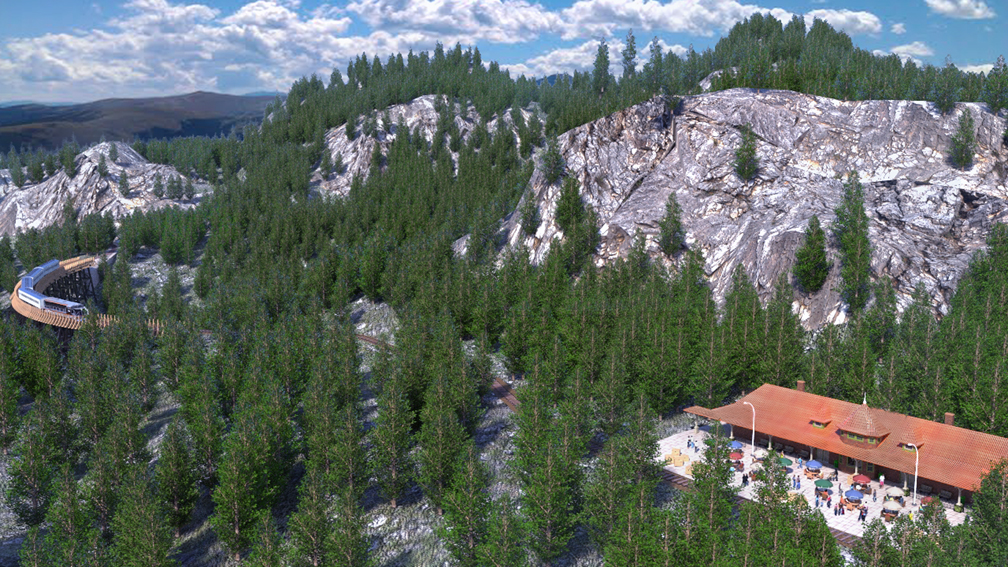
It’s actually not that hard. You’ll need to be working in SketchUp Pro,
as the free version of SketchUp is unable to import DWG files from
AutoCAD. You’ll also need to install several free ruby scripts—plugins
that customize your SketchUp application and increase its capabilities.
With a basic knowledge of SketchUp and the right tools, you should be
able to convert a 2D contour map from AutoCAD into a digital elevation
model in SketchUp in less than a day. Many different types of terrain
models can be created from small residential scales to larger master
plans (Fig 2 & Fig 3).
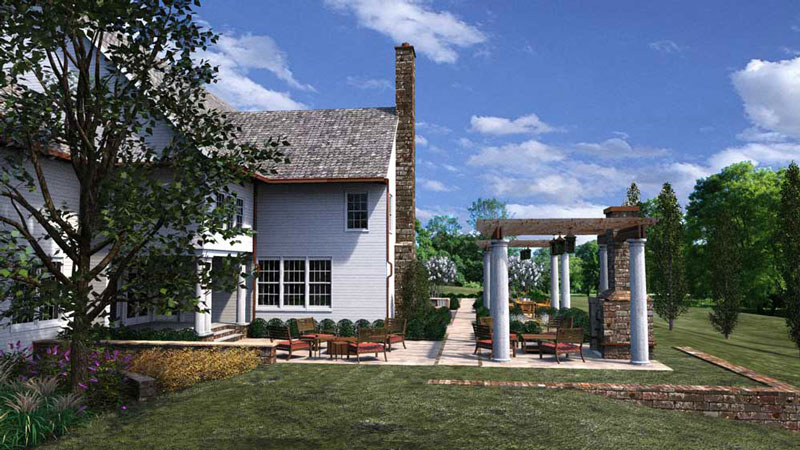
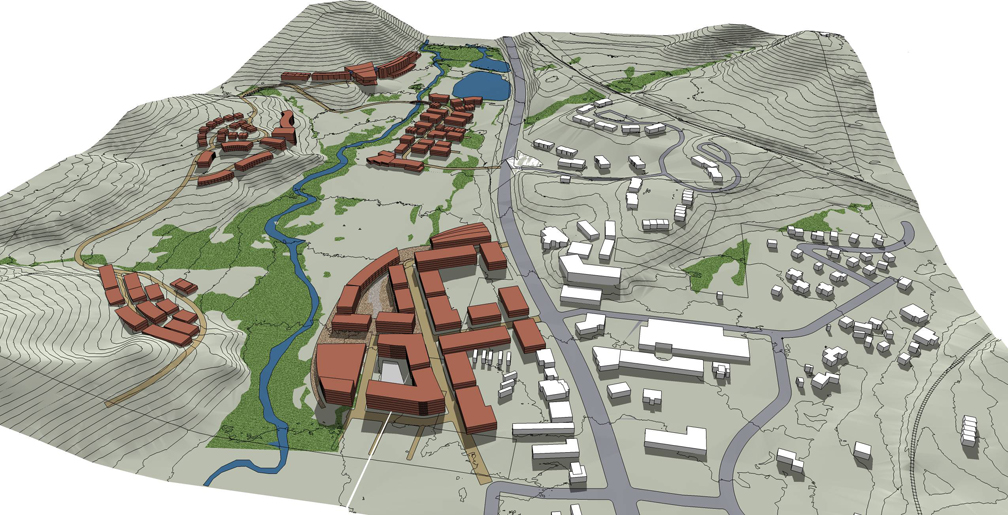
Such a model will give you a feel for how your design will actually look
on the land. It will also make your proposal much clearer to a client
who is not trained to read traditional grading plans (Fig 4).
But be warned that SketchUp has some limitations as a tool for grading
design. First is the accuracy of the generated terrain. SketchUp is able
to create a general representation of the site and grades but is not a
very good tool for fine grading. It does not have tools that can perform
Cut/Fill calculations or automatically indicate percent slopes and spot
elevations.
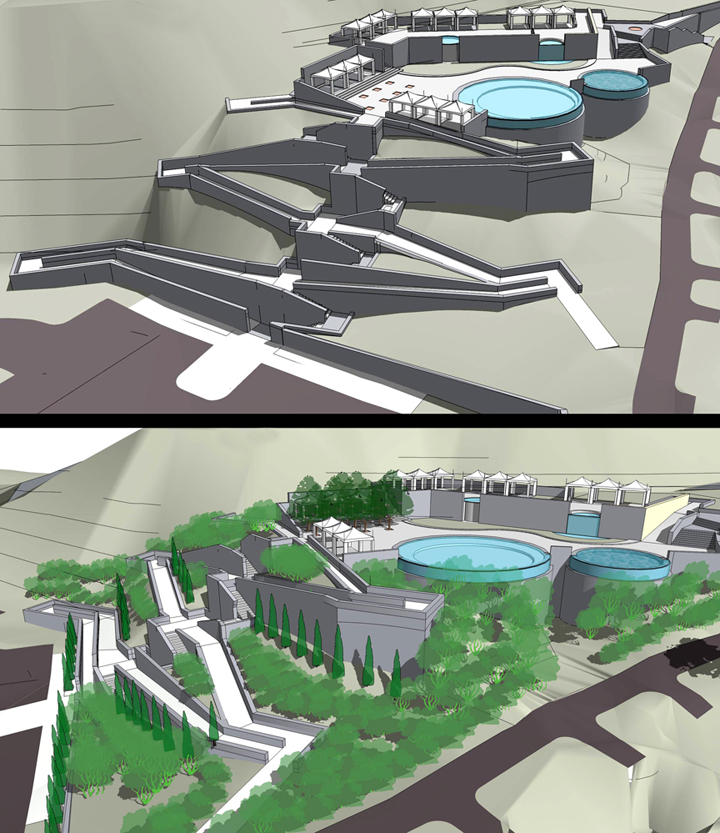
The process for creating SketchUp terrain models from AutoCAD plans
outlined below assumes you have some basic knowledge of grading, AutoCAD (or similar Cad programs0, and SketchUp. There are nuances throughout
the process that are not reviewed in this article. However, if you have
those basic skills, you should be able to navigate this methodology.
SketchUp Tools and Plugins
Before you begin, it may be helpful to review a few basic tools
that are included in SketchUp. The From Contour tool is used to generate
a digital elevation model from imported contour lines or other lines
with a Z-value. The tool stitches together contours, connecting vertices
with flat, triangulated faces. It can also be used to re-grade around
site elements like walls, steps, and other objects to merge them into
the terrain you’ve generated from the contours. Another tool, Drape,
let’s you project linework representing walks, roads and trails onto the
terrain model you’ve generated. These Sandbox tools are a part of SketchUp, but they may need to be enabled if they’ve never been used. If
you don’t know how to do this, google “enable sandbox tools SketchUp.”
You will also need to download and install four ruby script plug-ins
before you start. All of them are available for free online.
Simplify Contours is an essential tool, available through SketchUp’s
website. The Ruby Script removes about 50% or more of the points (also
called vertices ) that compose a typical surveyed contour line. The
Ruby selects vertices that are at shallow angles relative to each other
and removes them. This limits the loss of the terrains profile. The
greater the number of points or vertices, the greater the number of
faces created when using From Contour on imported contour data. This
will cause the terrain process to take considerably longer because SketchUp needs to process more information. Decreasing vertices makes
it easier for SketchUp to complete functions like From Contour and
Drape. Reducing the number of points that define a contour line reduces
the accuracy of that line; however in most cases the difference is not
noticeable.
Tools on Surface, also called Surface Operations, allows you to draw lines and shapes directly on terrain (Fig 5).
Its primary function is to supplement SketchUp’s Drape tool and fix
incorrectly draped line work. An Offset function allows contours and
outlines to be offset on the surfaces. The tool is available from SketchUcation (www.SketchUcation.com). Google “Sketchucation Tools on
Surface”. Free registration is required.
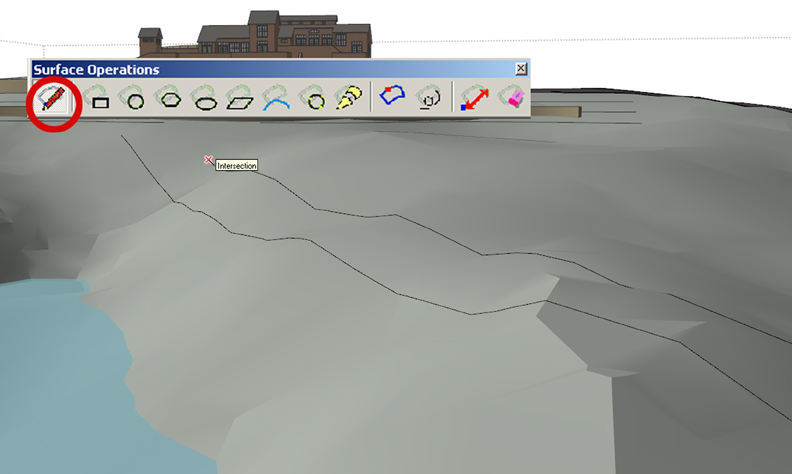
Joint PushPull allows multiple surfaces to be extruded or depressed
at the same time. For example, a road profile draped onto terrain can be
selected and depressed creating a 6” curb. Google “SketchUcation Joint
PushPull.
DropGC allows components representing vegetation and other objects
to be dropped onto terrain, so that they are directly on the surface.
This tool is essential for placing trees and other vegetation in one
quick step instead of trying to place each onto the terrain
individually. It is available from www.smustard.com
Additional Ruby Scripts
There are additional Ruby Scripts that are ideal for working with Terrain reviewed at the end of the article.
Preparing the File in AutoCAD
Before you open your grading plan in SketchUp, you will need to prepare it in AutoCAD (Fig 6).
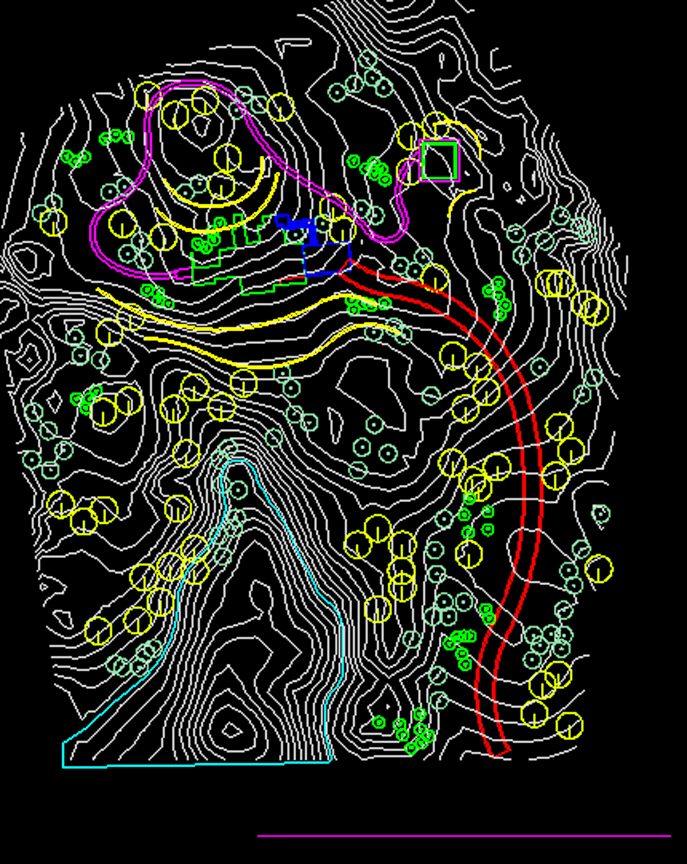
Check Z-values: All contour lines must have Z
values, representing their elevations. In AutoCAD, select and List a
contour line, and check the Z value. If it is 0 then the contour has no
elevation and you will need to type in its elevation using the
Properties menu. Pay particular attention to the proposed contour lines
that you’ve created yourself. Surveyed contours typically possess Z
elevations already, but it won’t hurt to check these too.
Your other linework—the roads, paths, walls, steps, and building
footprints, should all have a Z value of zero. If not, they should be
flattened in CAD. Freeze the contour data so it is not visible, then
type “flatten” in AutoCAD and select the site plan linework. AutoCAD will ask to include Hidden Lines as part of flatten. Answer “no.”
Close Polylines: You will also want to insure that
all linework areas are closed lines or polylines.. Closed areas are
easier to drape on the terrain. It is possible to fix flaws created by
draped lines that are not closed however, this can be a time consuming
processes. Better to have it done correctly in AutoCAD.
Minimize Contour Data: Minimize the amount of
contour data imported into SketchUp. The more contour lines the longer
the process can take and having more data does not necessarily make a
more accurate terrain model. SketchUp produces the terrain model using
the Z-value of the line—it does not require you to build from contours
at a regular interval. So, if you are showing a hill with a continuous
slope, it is not necessary to show every contour that makes up that
slope. Just showing the contours at the top and bottom should be enough.
Separate Different Layers into Separate Files:
Instead of importing your whole AutoCAD file into SketchUp, it’s best to
isolate different types of information and save it in separate files
using the WBLOCK command. I typically create separate CAD files for
contours, roads, trails, walks, walls and steps, building footprints,
and vegetation—which were each originally drawn on separate layers in
CAD. Each one of these files will be imported into SketchUp one at a
time. This insures that only relevant linework is inserted into
SketchUp, and adding the data to your model in stages makes it easier
for SketchUp to process (Fig 7).
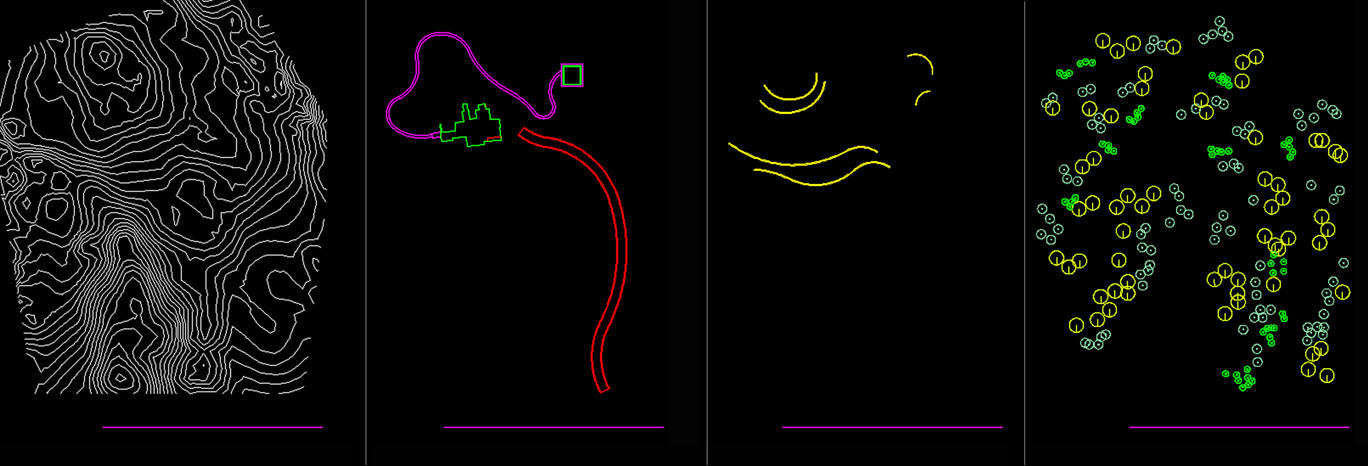
In order to align each file in SketchUp, you will need to create a
benchmark that can be included in each file. Create a new layer in
AutoCAD called Benchmark and make it the active layer. Then, draw a
horizontal line that does not cross any of your other linework (for
example in the bottom right of the plan).
Creating the Model
Importing DWG Files: Now it’s time to import the
files into SketchUp. Always start by importing the Contour information.
To import DWG files, in SketchUp go to File import, From the Browser
menu select DWG at bottom. Navigate to the location of files you saved
using the WBLOCK command and select the contour file. Once you’ve
imported the contour file, look to make sure the bench mark line is
present in the imported linework (it might be hidden behind one of the
Green or Red Axis line). This will save you a lot of headaches later.
If all the contour lines are a group, explode them.
Simplifying Contours for Easier Processing: Select
all the contours and use the Simplify Contour Ruby script on to remove
vertices. Once the plugin is selected, SketchUp will ask for an Angle.
This represents the angle of ‘bend’ between points (vertices) along a
contour line. The default of 10 usually works fine. SketchUp will
remove points that create angles of 10 degrees or less. The result is
some contour lines will be deleted while others will be straightened
slightly as some points are removed. If too many contours are deleted,
undo the result and try Simplify Contour again. This time try adjusting
the angle down in the hopes that SketchUp will not delete too many
contours. If this process does not work, create a terrain without using
Simplify Contour. However the rest of the process of draping and working
with the terrain itself will take longer and SkethchUp might function
at a slower rate due to having to process a greater amount of
information.
Create Terrain from Contours: Select all the contours again and
select From Contours on the Sandbox menu. This will stitch the contours
together, creating the triangulated irregular network (of faces) or TIN.
The created surface is a single group (Fig 8).
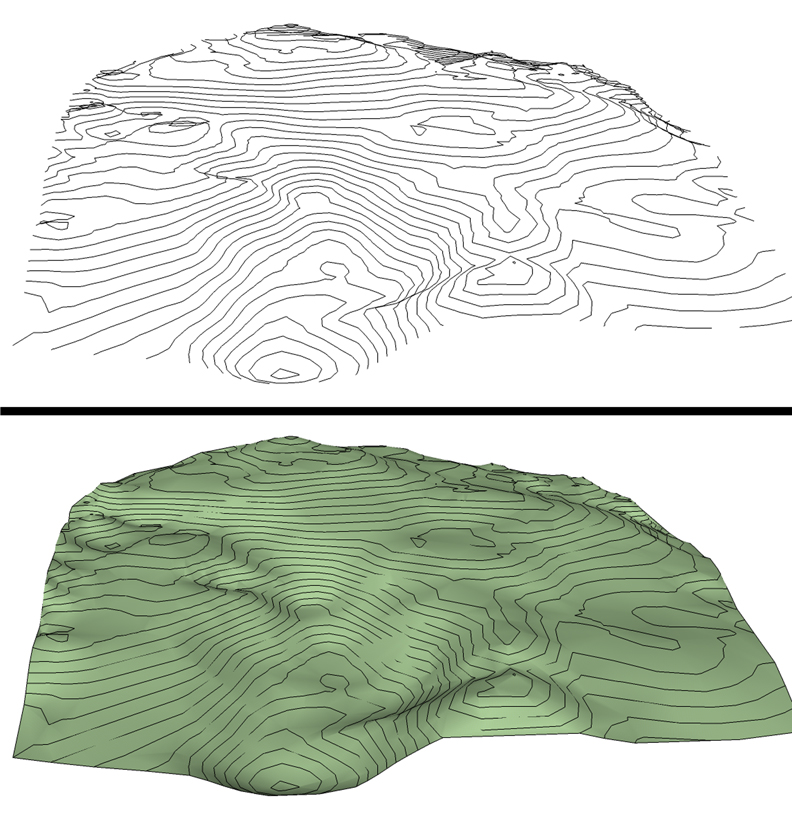
Overlaying roads, trails, and other linework on the terrain: Import
each of these layers individually to cut down on processing. When you
import the road linework, you’ll notice it is below the TIN. This is
because the imported linework has no elevation data. Use the benchmark
lines to align the information, and then move the linework directly
upward over the terrain model. You can lock the direction of movement by
using the up arrow on the keyboard when using the move tool. To drape
the linework onto the terrain, select the linework. Activate the drape
tool. Hover the drape tool over the terrain until it becomes selectable
(you’ll see it is highlighted in blue). Then, left click to activate the
operation. The roads should now be draped onto the terrain. The process
is identical for trails, planting areas and similar hardscape (Fig 9).
Painting the Draped Layers: Interested in painting the road’s
surface? Enter the TIN / Terrain Group instance, by double clicking on
the terrain surface. Select the area with the outlined road. If Drape
worked correctly the road surface should be its own discreet surface. If
drape did not subdivide the road surface, use Tools On Surface to fix
this issue. Using the Line on Surface tool draw an edge across the
intended road surface, dissecting it in half. The typical result is that
half the road will now be correctly subdivided. Continue to further
subdivide the road with the Line on Surface tool until the surface is
correctly subdivided. You can go back and erase all the extra lines
after this is completed. You should now be able to apply an appropriate
color to the surface. In this case, I’ve applied an Asphalt color to
the road area.
Extruding Surfaces to Create Curbs: If you wish to create a depressed
road with a curb, select the road surface and click Offset from the
Tools on Surface menu. The selected road surface can be offset inward 6
inches creating a curb outline. Next select the road surface, right
click over it and select Joint Push Pull. Depress the road 6 inches (Fig 10).
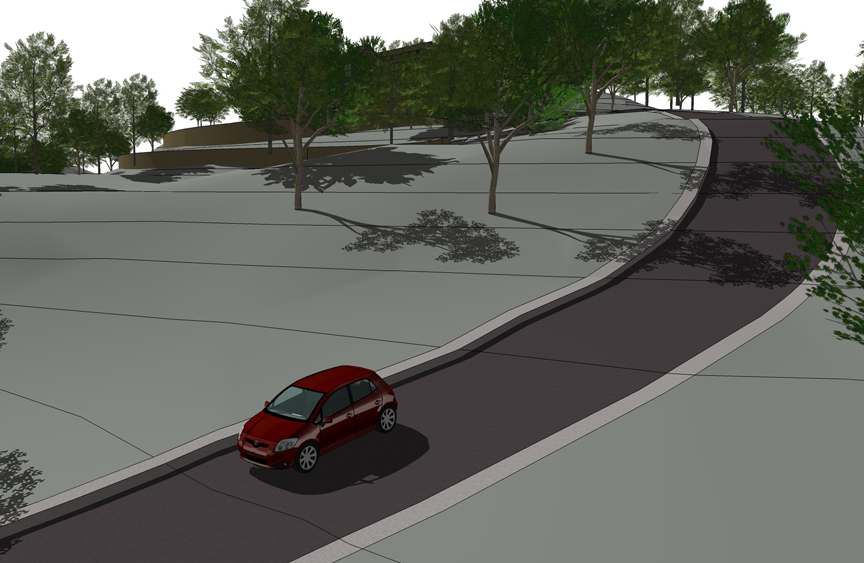
Grading Walls, Steps and Structures into the Site: Most site plans
will require that walls, steps and similar objects like buildings be
integrated into the terrain, not just draped on top of it. The process
is simple but does require you to think through the integration as a
grading exercise if you haven’t already.
First, the wall, steps or building are modeled, giving them extrusion
and volume. Next, they are aligned and placed onto the terrain. This is
where having proposed grades and spot elevations is useful, as it
allows these objects to be placed based on more accurate grading
parameters. For example, the building can be elevated based on its
finished floor elevation. Steps and walls can be positioned based on
bottom of wall or step elevations. If you are unsure about the correct
position (it has not been figured out), the placement of these elements
on the terrain to your best judgment.
Next, go to View - Hidden Geometry and make the hidden geometry
visible. This reveals the many hidden lines that make up the terrain
model, so that you can select individual faces of the terrain. Delete
terrain faces around the object that will be re-graded into the surface (Fig 11).
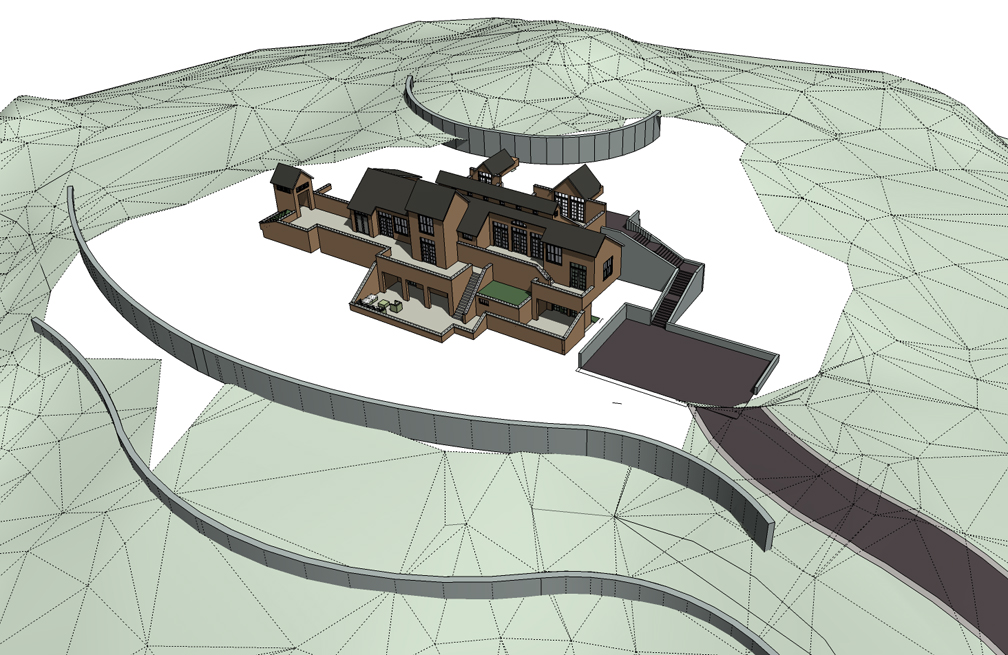
Select the terrain model group and enter the group instance by double
clicking on the terrain itself. Using [SOME SPECIAL TOOL?], draw edges
and arcs along the surface of the walls, steps or buildings. These lines
represent the location where newly generated grades will meet the
object. Be conscious of what lines and arcs are added and again,
consider this in terms of a grading exercise trying to achieve the most
realistic result for the object (Fig 12).

Select all these new lines and the edges of the adjacent terrain, then
activate From Contour on the Sandbox menu. This will result in the
terrain and object being integrated and graded. It might be necessary to
clean up some of the excessive created faces. Don’t hesitate to undo
and retry the process until the desired results are reached (Fig 13).
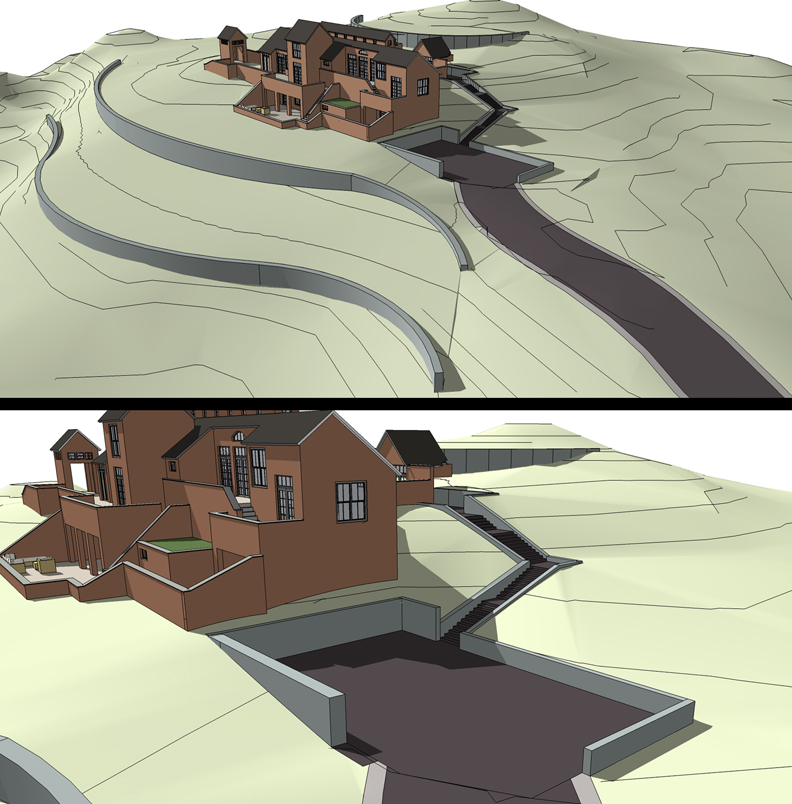
The Drop tool and Converting Vegetation Blocks to 3D Components
Vegetation and other site amenities, like pedestrian lights and
furnishings, can be quickly and easily placed onto the terrain. But
these features are typically imported as 2D blocks rather than linework,
so the drape command will not work on them.
Import the file containing these blocks, align it using the benchmark
and move the blocks up over the terrain. Explode the group containing
the blocks, but be sure not to explode the individual blocks themselves.
It is recommended that you save the file first before performing the
next step as it is not possible to undo this step. Select the blocks,
right click over one of them and select Drop at Intersection from the
right-click context menu Once dropped, each block will hug the terrain (Fig 14).
If Drop does not work it is because an object other than a component or
group was selected. Sometimes it’s best to perform Drop on a limited
number of blocks to insure the process works.
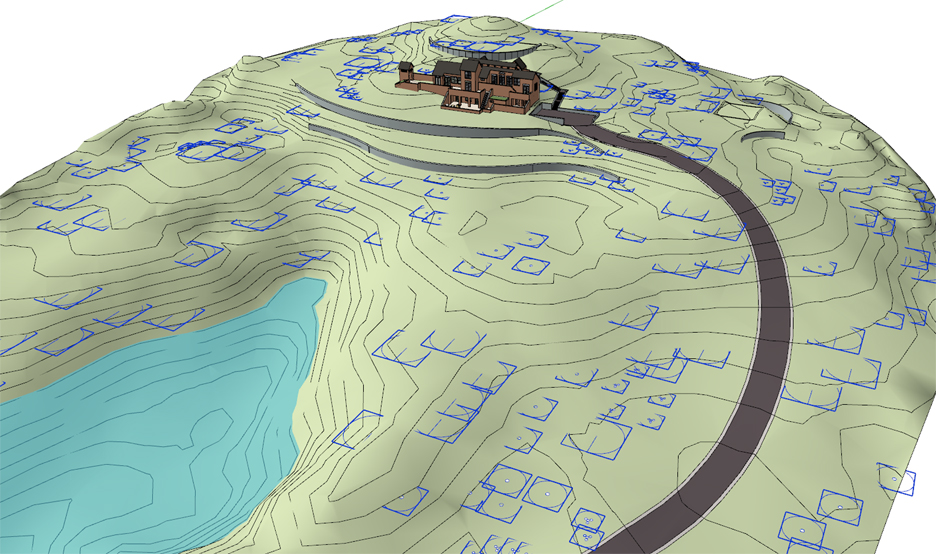
Replace the blocks with 3D components by selecting and right-clicking
over a block. This will bring up the right-click context menu. From the
options, select Reload. Navigate to your component folder and select a 3D component to replace the block. For example, you can select a 2D
block representing a tree and then reload a 3D tree to replace it. All
versions of that 2D block will be replaced with a 3D tree (Fig 15 & Fig 16). Repeat this step for every block and object type.
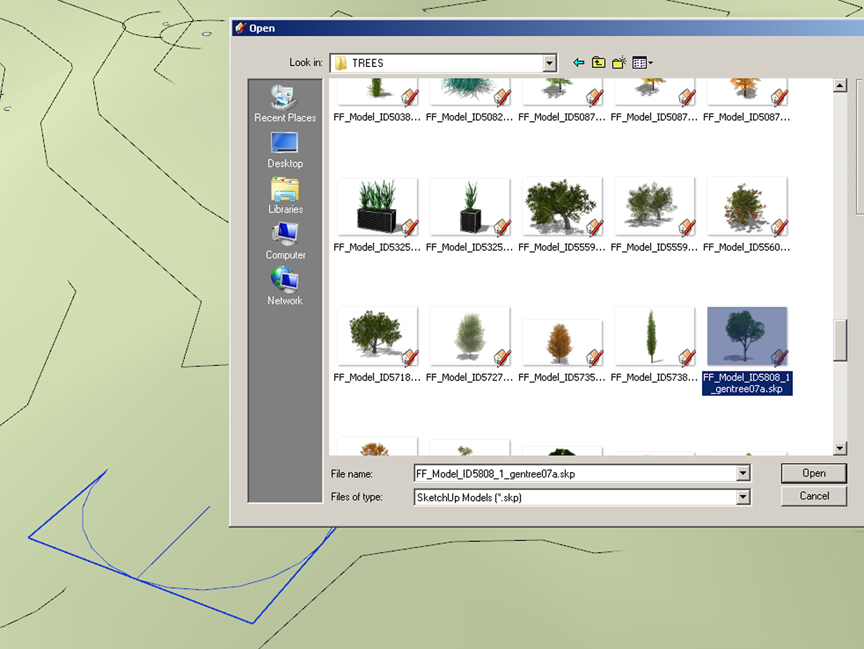
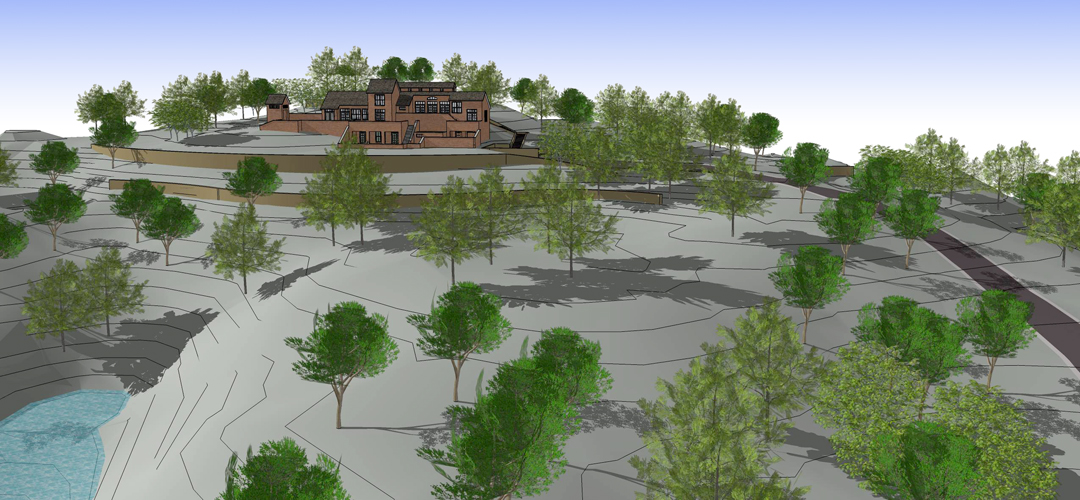
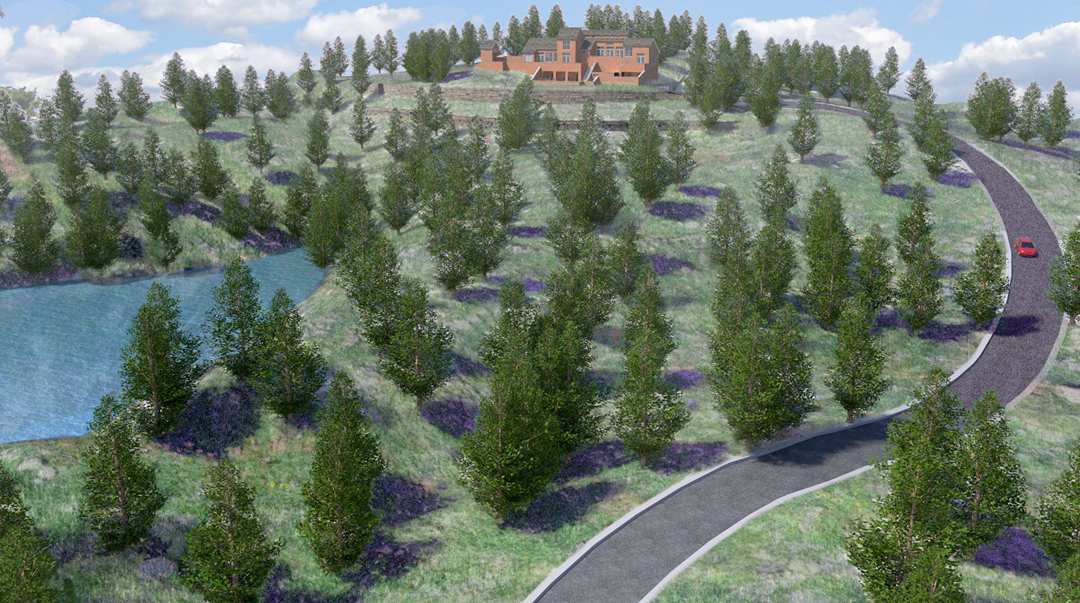
Additional Ruby Scripts and Software for grading:
The tools laid out above will provide some basic functionality. But
there are additional plugins that can help streamline the process. These
tools are not free but solve some of the issues that SketchUp has when
working with the base method; for example, by creating finer and
smoother grades.
The Ruby Script Instant Road by Vali Architects (www.valiarchitects.com - cost $25) allows for draping a single face representing a road onto terrain (Fig 18 & Fig 19).
The Plugin grades the road onto the surface creating a much smoother
and realistic surface in comparison to the Drape tool. Instant Walls is
an excellent tool allowing for the creation of walls, colonnades,
fences and more by simply drawing a line, series of lines or arcs on
surfaces, selecting the drawn edges and with one click converting them
into the chosen element (Fig 20). These auto-generated structures will hug the terrain once created (Fig 21).
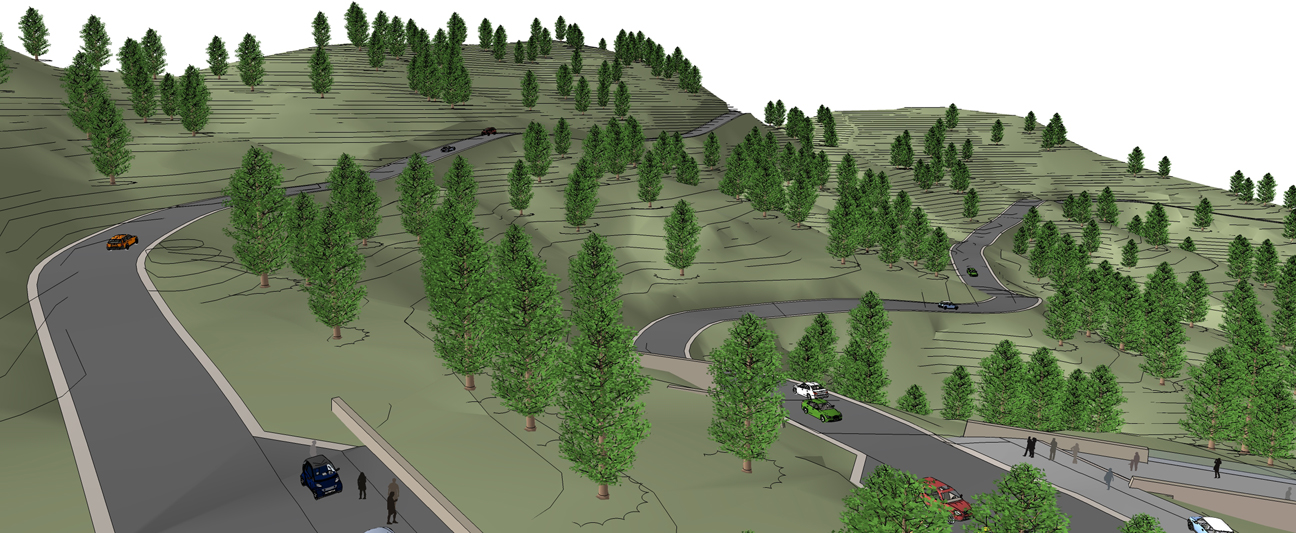
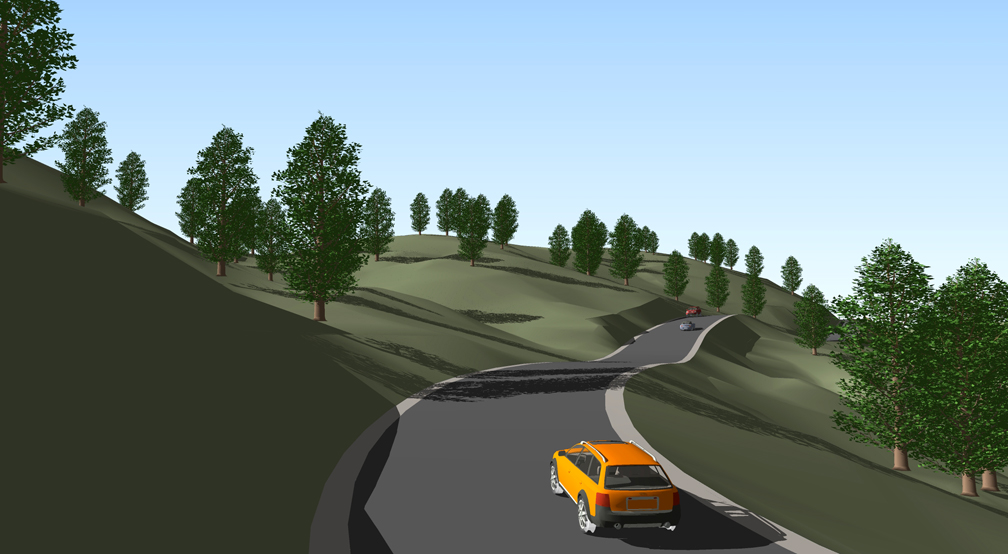
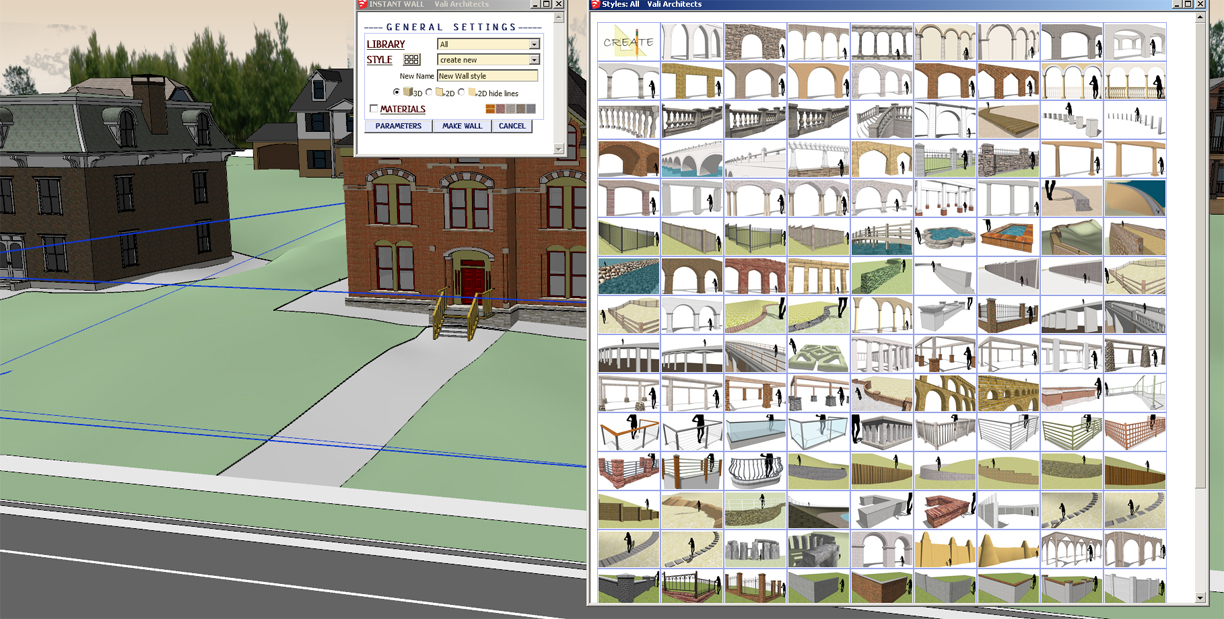
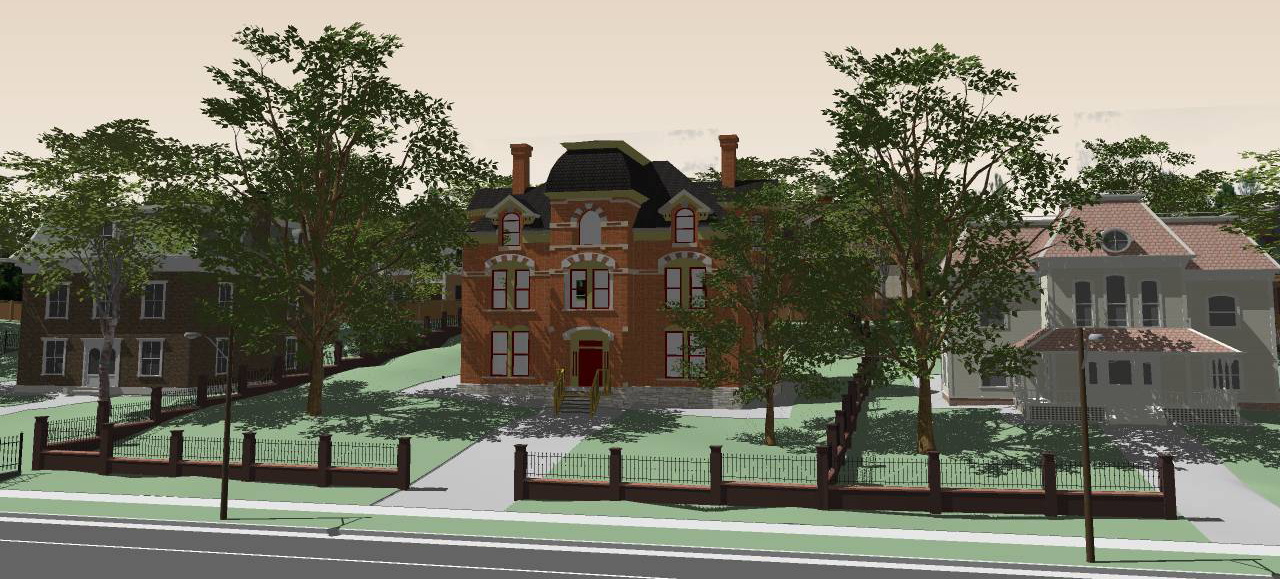
Other scripts by Vali include Instant Roof and Instant grade, which
are worth exploring as they are quick shortcuts to creating detailed
structures and integrating site elements into terrain.
A ruby script called Artisan created by the civil engineer Dale
Martins is a series of tools bundled in a single menu that allow you to
work with complex forms and shapes common in terrain modeling. These
tools offer alterative to the some of the clunky counterparts found in
the Sandbox menu. For example, the Artisan Sculpt Brush provides an
excellent way to extrude or depress terrain creating swales, hills or
other landforms by simply dragging the tool across the terrain surface.
The strength of the tools extrusion is easily adjusted using the arrow
keys on a keyboard. Other Artisan brushes make it quick to select
terrain surfaces, level areas of terrain, or select surface vertices.
Not to mention the many other tools it includes to further refine
organic forms and shapes making Artisan is indispensible. The tool cost
$39 and can be purchased at www.artisan4sketchup.com. There is an
excellent post by SketchUp on their offical blog about Artisan: http://sketchupdate.blogspot.com/2011/03/organic-modeling-with-artisan-plugin.html
There are more tools beyond these as well. For example, it is
possible to create terrain from point / cloud data using the right Ruby
Script (ask on SketchUcation is this is what you need). Additional Ruby
Scripts provide the means for further smoothing out terrain and
generating new contour lines from any adjusted grading done to the
model.
Daniel Tal is a landscape architect and Author of the forthcoming
book, Rendering In SketchUp: From Modeling to Presentation for
Architecture, Landscape Architecture and Interior Design (due on book
shelves in February 2013). The book reviews how to create photorealistic
graphics in SketchUp. Daniel is also the author of Google SketchUp for
Site Design. To find out more about Daniel and related services go to www.ambit-3d.com or contact Daniel at ambit3d@gmail.com
~~~~~~~~~~~~~~~~~~~~~
Published By
Arka Roy
www.sketchup-ur-space.com
~~~~~~~~~~~~~~~~~~~~~
No comments:
Post a Comment